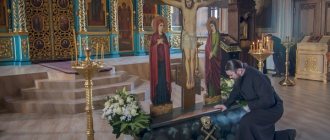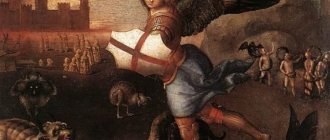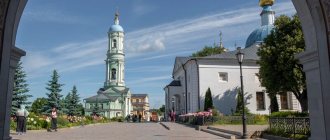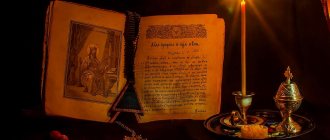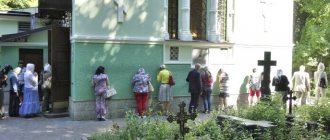A pilgrimage is a journey of believers to holy places. Translated from Latin, the word means “palm” - branch. The same palm branches with which the Jewish people greeted the Lord Jesus Christ upon entering Jerusalem. Palm Sunday is now celebrated by Orthodox Christians in Rus' with willow branches, since in our area it is difficult to find palm trees, these southern trees. But the meaning is the same - honoring the Lord, joy at His coming to us.
Orthodox pilgrimage
For a long time, pilgrimage was held in high esteem in Holy Rus'. This ancient tradition is still revered today. Despite the fact that his character has changed somewhat, the essence remains the same.
By the grace of God, holy places are usually connected with the earthly life of the Savior, the Mother of God or saints.
Pilgrimage is common not only in Orthodoxy, but also in other faiths:
- Catholicism;
- Islam (Hajj);
- Hinduism;
- Buddhism;
- Judaism (pilgrimage to Solomon's Temple).
On such long journeys, people express their innermost relationship to faith , to invisible things through the worship of visible objects and places. Pilgrims were otherwise called “pilgrims,” which means strangers.
Orthodox Christians are confident that through visiting holy places and touching shrines, the Lord will give them Grace, health and the fulfillment of their requests. This is usually healing from long-standing illnesses that doctors could not cure. Or the gift of children in case of infertility. Some receive answers to the questions that tormented them. Some people have their housing problems resolved, etc.
The Lord abundantly sends His Grace in holy places to those who with faith make a long journey with one goal - to touch the shrines, walk the earth that Christ walked, and look at the dwellings of the saints.
Pilgrimage is proof of a person’s faith, confidence in invisible things, the presence of the Divine in shrines.
A little history
The pilgrimage was known long before the Coming of Christ. The Old Testament tells of the Jews' journey with the Tabernacle and later to the Temple in Jerusalem. Jewish believers made a pilgrimage to the Temple every year for the holidays. The Gospel also tells about this, how the Mother of God, according to the Law of Moses, came to the Temple with Joseph and the Infant Christ to make an atoning sacrifice for sin. Later, She, Joseph, and twelve-year-old Christ went to Solomon's Temple for a festival, where He became lost.
Despite the mortal danger, the Apostle Paul made a pilgrimage to the Temple. There he was captured and taken into custody.
History tells that the first Christians also had the custom of pilgrimage to holy places associated with Christ. Even in the fourth century AD, Saint Gregory of Nyssa testifies to this, but also warns that these trips should not turn into idle pastimes.
In the Middle Ages, Orthodox Christians began to make pilgrimages not only to the Holy Land, but also to Mount Athos. Among Catholics, pilgrimages were divided into small (in their locality) and large (to Rome, to the House of Our Lady of Loreto, etc.). Catholics had special outfits when making a pilgrimage, by which they could be recognized: a gray cloak, a wide-brimmed hat with a large cross .
How can we help?
Let's say, in Karsava near Fr. Viktor Mamontov, it’s customary to wash dishes together, chop wood, carry water, cook food... By the way, this brings us together incredibly! And it doesn’t matter that in some monastery the sisters are ready to do everything themselves - why don’t we take it upon ourselves and give them a rest? Am I willing to serve others as a responsible person? Or, without any official role, take care of the weaker member of the group and help him? Bringing little joys and an atmosphere of celebration into the group?
In organizational terms, it is necessary that those responsible for the following areas be selected or appointed:
- Management. The main responsibility is for people and making important decisions: who to invite and hire, how to create a program, meetings. Behind it are fundamental agreements on transport, accommodation, meals, excursions. He needs to meet separately with all those responsible for the areas before the start of the new day. If people trust him as a spiritual figure, then perhaps his main task is simply to communicate heart-to-heart with the participants, listening to them.
- Accommodation and excursions. If the program requires a lot of travel and takes place in a not very well-known place, it is worth dividing the responsibility for finding accommodation. Here it is better to start with advice from experienced people and consider working with a travel agency.
- Money. Collects money, keeps records, issues it against receipt.
- Route. Thinks through the details of movements, prepares maps, navigates the area and is ready to explain how to get where, always with a phone number and a plan.
- Accommodation and nutrition. Thinks through who to stay with whom, keeps records of accommodation and meals, and interacts with the receiving party. Also, if necessary, draws up a duty schedule.
- Prayer. You can prepare prayers and songs in advance - in an electronic or printed collection. You can choose new people responsible for the day - for the form of prayer, the primate at matins and vespers, and assign the sermon to be delivered. There is an empty seat at the microphone on the bus.
- Mode, group gathering. Reminds the time, recalculates the group.
- Group health. Finds out about the medical conditions of participants, makes sure everyone is dressed appropriately, reminds about travel requirements (for example, carry a sun cap, sunscreen or mosquito repellent, drink regularly).
- Small group leaders. It is better if a large group does not walk in a crowd, but is divided into small groups, each of which has its own more prepared leader: he knows the program, the route, makes sure that no one from his group gets lost, the participants address all questions first. to him. It would be good if he himself could act as a guide, but not necessarily.
Sometimes, if the person in charge does 80 percent of the work and doesn’t finish something, it is necessary to appoint two people so that the other can cover the remaining 20.
It is important that the participants know these responsible people and resolve most issues with them, only with the most important ones they go to the general leader (and preferably at a special time, without depriving him of the opportunity to have lunch in peace, for example).
Pilgrimage in Rus'
Pilgrimage in Rus' was a very dangerous business in ancient times and therefore especially revered. The fact is that believers walked to the Holy Land. The path was not easy and life-threatening. Sometimes the provisions ran out too early. Many died on the way from hunger and cold, sometimes from overwork. Sometimes they became victims of robbers, evil people.
Believers sometimes made a vow to make a pilgrimage to the Holy Land while fulfilling what they asked of God . This occupation was considered “holy”; pilgrims, or otherwise “wanderers”, were respected and accepted into every home. It was considered a special matter to receive and feed strangers. Pilgrims gathered in groups (dozens) and traveled together. It was safer that way.
Sometimes foreign church authorities disapproved of pilgrims and took measures to curb pilgrimage. But the Russian wanderers won a victory in this regard.
During the reign of Catherine II, pilgrimages to the Holy Land were suspended due to wars with Turkey. But already in the nineteenth century it began to spread freely again.
Even the Orthodox Palestine Society was created.
Preparation meetings
Preparation for the pilgrimage begins in advance, three months in advance would be good. It is important not to look for community on the spot, and especially not to solve organizational issues there, but to go there ready.
To achieve this, several meetings are held with participants, and additional information is provided via the Internet. If someone regularly cannot come to training meetings, this is a reason to warn that the person may not be accepted. By skipping preparation, most often a person already on the spot creates additional difficulties for himself and others with questions that are not clarified in time, or even disagreement with the general course of the pilgrimage. People may doubt whether they will actually be able to participate (due to money, due to life circumstances), but if they want to participate, let them come to general discussion meetings. Registration of participants, accordingly, must have its own deadline. The manager announces this, and after the specified time, someone should be accepted only as an exception. Sometimes the restrictions are not related to dates, but to the size of the group - for example, a bus for 19 people, or a place to stay for a certain number of people. In this case, new students can be put on a waiting list.
First meeting. At the first meeting, you can ask the participants to tell a little about themselves from the point of view of participation in church life, about their spiritual education, ministry, and interests. What do they want from the trip? You can also ask a direct question: what are your strengths and weaknesses in communication, when traveling, are there any health features that need to be taken into account. At the first meeting, you can offer to distribute responsibility, or offer to give an answer by the second meeting.
Everyone needs to collect contacts; if traveling abroad, offer an option for how communication will be carried out - and collect foreign contacts in advance as well. Before the start of the trip, the leader must have a complete list of telephone numbers, as well as the participants - a list of telephone numbers of those responsible and places of residence.
It is important to start praying about the trip from the first meeting.
It would be good to determine a place (correspondence, a group on a social network or a forum) where up-to-date information about the trip will be posted, and agree to watch it regularly (at least once a week for a month and every two days for the last month). If someone cannot, he asks to be informed separately by SMS. You can assign the posting of information there to a separate person.
Second meeting. It is worth having an approximate program, taking into account the wishes of the first meeting, by the second meeting, and sending it to everyone in advance for discussion. At the second meeting, it should finally become clear with those responsible. After a detailed discussion of the program, you can draw up an approximate cost estimate and send the total amount per person as early as possible, especially if the trip involves significant expenses. It is necessary to set aside 30% for organizational expenses and unforeseen needs. It is immediately necessary to collect a minimum contribution, part of which is withheld if the participant refuses without good reason (illness, something with relatives, etc.) the day before. This fee can be increased as the travel date approaches. If you are traveling abroad, you should inform yourself in advance about the currency of the fees. The updated estimate must be sent to participants no later than 2 weeks before the start of the trip.
For all counterparties (travel agency, accommodation) - it is necessary to contact as many participants as possible in advance so as not to be hostage to one option. If the pilgrimage occurs during a tourist boom, preparations in this matter must begin six months in advance.
Next are meetings with those in charge, and on the eve of the trip - a general prayer meeting, final clarifications.
Pilgrimage in our time
Nowadays, the pilgrimage has not lost its significance. And although the path has become much easier thanks to the development of transport, its goal remains the same. Some churches organize pilgrimage trips for believers using their own transport and gather groups of pilgrims. This happens regularly. On the way, believers read akathists, sing troparia to the saints, and pray.
Currently, pilgrimages are being made to holy places in Russia and abroad.
Favorite places, in addition to the Holy Land, are:
- of St. Nicholas rest ;
- the island of Corfu, where the incorruptible relics of St. Spyridon of Trimifuntos and others lie.
There, believers pray, collect and take with them, with blessing, the holy myrrh from the relics. Some receive healing from illnesses there.
Also, the male population of Russia strives, of course, to visit Holy Mount Athos , where the Mother of God Herself visited. With their own eyes, believers see the miraculous icons of the Mother of God (“Consolation and Consolation,” for example), and venerate the relics of the holy healer Panteleimon in the Russian monastery named in his honor.
In addition, many try to see with their own eyes the Shroud of Turin , which is kept in the Cathedral of Rome.
Holy places in Russia
There are also many holy places in Russia that Orthodox Christians aspire to. This:
- Tolgsky convent with the miraculous icon of the Mother of God and the relics of St. Ignatius Brianchaninova;
- Seraphim-Diveevskaya monastery with the relics of St. Seraphim of Sarov ;
- Trinity-Sergius Lavra with the relics of St. Sergius of Radonezh ;
- Optina Pustyn, where the relics of the holy elders rest;
- Nikitsky Monastery in Pereyaslavl Zalessky with the relics, pillar and chains of St. Nikita the Stylite .
This list can be continued for a long time. The main thing is that the Russian people still live by faith in Christ and continue to preserve the ancient traditions of their ancestors. The Russian faith is alive to this day. That is why miracles occur abundantly in holy places.
prot. Alexey Ladygin answers questions about the pilgrimage
The meaning of the word Pilgrimage according to the Brockhaus and Efron dictionary:
Pilgrimage - the belief that prayer is more effective in certain areas that have one or another relation to the deity, was already characteristic of the peoples of the classical world. The Greeks and Romans made journeys to distant temples, the Germans flocked to sacred groves. The Jews traveled annually to Jerusalem on great holidays. In the Christian world, P. in the country where the divine acts of the Savior were performed came into practice in the 4th century, mainly under the influence of the example of St. Helena, whose journey to St. in some places led to the erection of the Cross. The Lord's. Already in the 4th century. we encounter guidebooks to the Holy Land (Bordeaux Traveler of 333, ed. in the 2nd issue of the “Orthodox Palestine Collection”) and descriptions of P. (the journey of an unnamed pilgrim at the end of the 4th century, ed. by I. V. Pomyalovsky in 20th issue of "Orthodox Palestine Collection", St. Petersburg, 1880). At the end of the 4th century. The church fathers (Gregory of Nyssa), for moral reasons, took up arms against P.’s hobby, but it was soon recognized by the church as a matter pleasing to God. The Crusades (see Crusades) were essentially grand, mass pilgrimages. The Western Church distinguished between great (peregrinationes primariae) and small pilgrimage (peregrinationes secundariae). The first, in addition to the pilgrimage to the Holy Sepulcher, also included travel to Rome (Limina apostolorum), Compostella (see) and Loreto (see), the second meant visiting local domestic shrines. The church began to impose this or that penance as penance, and from the 13th century. and secular courts of the West. Europe began to sentence murderers to P. however, in the 14th and 15th centuries, secular courts abandoned the imposition of large penalties, limiting themselves to small, but repeated ones. Gradually, further mitigations began to be allowed: a noble gentleman could replace himself with a servant or a mercenary. Even secular guilds of professional hired pilgrims (called Sonnweger in Germany) were formed, which soon multiplied greatly, since this peculiar trade turned out to be very profitable. In the 16th century and the communities equipped pilgrims at their own expense. P. especially intensified in the 14th century, when it became clear that the Muslim authorities were friendly towards Christian pilgrims, charging them only a certain tax, and the lively relations of Venice with the Levant made it possible within 6-8 months to carry out P., which until then had been considered a very lengthy and extremely dangerous enterprise. To undertake P., prior permission from the spiritual authorities was required, which at the end of the 15th century. was given under the condition of payment of a certain fee in favor of the pope. The departure point was Venice (later Marseille), where pilgrims stocked up on a guidebook (the most famous of them is “Peregrinationes Terrae Sanctae”, Venice, 1491), grew a beard and put on pilgrimage clothes - caligas (see), a brown or gray cloak, a Greek hat with a very wide brim, usually decorated with shells. a stick (see), a bag and a bottle (a hollowed-out pumpkin) complemented the pilgrim outfit. Pilgrims attached a red cross to their cloak and hat. In Venice, the pilgrim entered into a contract with the shipowner (patron), who undertook not only to transport him to the Holy Land and back, but also to accompany him on his travels around the Holy Land. places, provide him with food and protection throughout the journey, pay taxes for him to the Muslim authorities, etc. In Venice, there was a certain supervision over the shipowners involved in transporting pilgrims. so, in the 15th century. there was a regulation according to which the ship on which pilgrims were transported could not at the same time serve for trade purposes. Western pilgrims visited holy places from Zion in processions, during which they sang spiritual songs. It was not only religious zeal, which sought to venerate the places that were witnesses of the Passion of the Lord, that attracted pilgrims to Jerusalem. Among them were nobles seeking knighthood at the Holy Sepulcher, political and military agents of kings hiding under the humble cloak of a pilgrim, adventurers seeking occult knowledge in the miraculous East, and scientific researchers (Justus Tenellus and Wilhelm Postel, on behalf of the French . King Francis I, collected manuscripts in Palestine for the Parisian library), and, finally, merchants who visited Palestine for trade purposes. Among the latter, from the 16th century. there were especially many English and Dutch people. The Reformation dealt a decisive blow to Catholicism. Catholicism is still being practiced in Catholic countries today, although on an incomparably smaller scale than in Russia. In 1881, a pilgrim caravan to the Holy Land began to be organized annually in France, giving it the character of an offering of repentance for the crimes of the republican government against the church. The composition of such a caravan, the number of which often reached 300-400 people, included members of the white clergy and wealthy people of the ultramontane mood. Since the late 1870s, similar German caravans have been organized by the Franciscans in Vienna and Munich. In Russia, pilgrimages to the Holy Land began already in the first times of Russian Christianity. OK. half of the 11th century Dmitrievsky's abbot Varlaam was in Palestine (1062). From Kirik’s questions to the Novgorod bishop Nifont it is clear that by the 12th century. the passion for P. spread so much that the church authorities found it necessary to restrain overly zealous pilgrims, who, apparently, had the idea that P. was necessary for the reality of spiritual salvation. Even among the first Russian pilgrim, the writer Abbot Daniel (beginning of the 12th century), we find indirect disapproval of P., he condemns those who, in their wanderings, “are exalted in their minds, as if they have done nothing good, and destroy the reward of their labor,” while, staying at home , you can serve God better. One must think that already in this distant era the type of “kaliki wanderer” (see) began to take shape, who went to Constantinople, Mount Athos, Egypt, then wandered around domestic shrines and, finally, turned this wandering into a profession. The difficulty and danger of the journey forced pilgrims to gather in “squads.” Making their way mainly through Constantinople, ancient Russian pilgrims borrowed costumes from Western pilgrims. Kaliki played a huge role in Rus' in the spread of legends and apocryphal literature. In the sparse ancient Russian literature, descriptions of “walks” to the Holy Land left by some pilgrims were also of great importance. The first Russian pilgrim-writer is Daniil-mnich (see), the second is the Novgorod archbishop. the end of the 12th century, Anthony (q.v.), who, however, limited himself to the Constantinople shrines. Around 1350, the Novgorod monk Stefan performed a pilgrimage, who described, or rather, listed (ed. in Sakharov, “Tales,” vol. II) the Constantinople shrines. The description of his journey to Jerusalem has not reached us. By the 70s XIV table. refers to “walking archim. Agrefenya monastery of the Most Holy Theotokos,” apparently from Smolensk (edited by Archimandrite Leonid in issue 48 of the Orthodox Palestine Collection, St. Petersburg, 1896). This is the first pilgrim after Daniel who left us his journey to Jerusalem. Agrephenius is close to Daniil in his ancient and figurative language (colloquial language), in the completeness and systematicity of his presentation, which bears the stamp of freshness and careful study of the places and objects described. He is followed by Deacon Ignatius Smolyanin (q.v.), who walked at the end of the 14th century. to Constantinople, Jerusalem and Mount Athos. Along with the pilgrim-writers of the 14th century. the Novgorod apxbishop Vasily (see) should be installed, although he did not leave a description of his wanderings, but undoubtedly brought his message about the earthly paradise from the East. Included in the pilgrimage literature of the 14th century. also includes “Conversation on Shrines and Other Monuments of Constantinople,” ed. L. N. Maikov in his “Materials and Research on Ancient Russian Literature” (St. Petersburg, 1890). The moralizing part of the “Conversation” was probably taken or translated from some Greek. guidebook, but the descriptions of the shrines themselves apparently constitute a Russian composition. Since the 15th century the number of trips is increasing and they are becoming more diverse. The type of stories remains the same, but the conditions of the journey have changed, and the pilgrim, of necessity, goes into details about the journey itself, which in the past were most often kept silent. The first wanderer of the 15th century to describe his journey was the Trinity Hierodeacon Zosima (see), who went to Constantinople, Athos and Jerusalem in 1420. Zosima was trusting of what the cunning Greeks told and showed (Noah’s axe, Abraham’s meal). not a skilled scribe, he sometimes repeated entire phrases from the pilgrim Daniel, but such copying was then the general rule. Zosima’s “xenos” is followed by “the journey of the holy monk Barsanuphius to the holy city of Jerusalem,” discovered by N. S. Tikhonravov in 1893 in a manuscript of the first quarter of the 17th century. It contains a description of two walks: one made in 1456 to Jerusalem from Kiev through Belgorod, Constantinople, Cyprus, Tripoli, Beirut and Damascus, and the second, made in 1 4 61-1462. through Belgorod, Damietta, Egypt and Sinai, and published in the 45th issue. “Orthodox. Palest. Collection" (M., 1896). Barsanuphius was the first of the Russian pilgrim-writers to describe St. Mount Sinai. After him, among the pilgrims of pre-Petrine Rus', only Poznyakov, Korobeinikov and you described Sinai. Loon, but the description of Barsanuphius, in terms of accuracy and abundance of data provided, far surpasses these latter. Almost simultaneously with Barsanuphius, in 1465-66, he wandered around St. in some places there is a guest (merchant) Vasily, who begins his story directly from Brussa (ed. by Archimandrite Leonid in the 6th issue of the “Orthodox Palestine Collection”, St. Petersburg, 1884). To the monuments of pilgrimage literature of the 15th century. include “The Tale of Epiphanius Mnich about the path to St. city of Jerusalem." dating back to 1415-17. and which is a simple list of cities along the route from Veliky Novgorod to Jerusalem, indicating the distance between them. Its author is considered to be Epiphanius the Wise (see). ed. in the 15th issue. "Orthodox Palestinian Collection". From the half of the 15th century. In our pilgrimage, a turning point is taking place. Already the former “pilgrims” are full of complaints and indignation at the oppression of the “sratsyns” and “evil araps”. The capture of Constantinople by the Turks finally delivered the Christian shrines of the East into the hands of the infidels. At the same time, the Russian people arose, and over time grew more and more, an idea of the great significance of their own state, which remained the only Orthodox kingdom, preserving the purest tradition of Eastern Orthodoxy, while the Greeks weakened in faith. The student and biographer of Sergius of Radonezh, Epiphanius the Wise, at the beginning of the 15th century, especially praised him for the fact that he “did not seek the reigning city, nor the Holy Mountains, or Jerusalem, as if I were accursed,” but found holiness in the inner search for God. Somewhat later, Pachomius Serbin in the life of the same Sergius (about 1440) emphasizes the fact that the great Russian ascetic “shone not from Jerusalem or Zion,” but raised his piety precisely “in the great Russian land.” With the weakening of P. in the East, pilgrimage notes also disappear from our writing for a long time. Only in the second half of the 16th century. walking appears again. Most often these are the results of, so to speak, official P., the writings of people who were sent to Moscow. government to the East with errands and alms. This primarily includes circulation in 1558-61. merchant Vasily Poznyakov (see). His description of the Jerusalem and Sinai shrines was entirely included in the famous “Walking of Trifon Korobeinikov” (see) - the most widespread work of pilgrimage literature, which from the end of the 16th century. and has remained in popular reading to this day, overshadowing everything that preceded it, and not giving way to any new descriptions of St. places The well-known “Proscinitary” of Arseny Sukhanov (see) also owes its origin to the official commission. Out of motives of personal piety, the pilgrim-writers of Vas made their walks. Loon (q.v.) and Jonah the Little (q.v.). They end the series of pilgrims-writers of pre-Petrine Rus' [Published by A. S. Petrushevich “A Traveler about the City of Jerusalem, compiled by Galician-Russian between 1597-1607.” (Lvov, 1872) turns out to be a translation of the Greek. Proskinitary (guidebook), ed. in the 26th issue. “Orthodox. Palest. Collection" (St. Petersburg, 1890). Meletiy Smotritsky (q.v.) compiled “Apology for my wanderings to the East,” which was published. in the Dermak monastery in 1628, translated into modern pvc language published by the Jesuit Martynov (Lpts., 1863).]. but the ancient Russian type of pilgrimage survived until the 18th century. The pilgrims of 1704, hieromonks Macarius and Sylvester (“The Traveler”, their editorship was Archimandrite Leonid in “Readings of General History and Ancients,” 1873. Vol. III) took a lot entirely from Trifon Korobeinikov. The traveler of 1710-1711, the Old Believer priest Lukyanov (see), already talks more about his personal impressions. Of the very few other pilgrim-writers of the first quarter of the 18th century. Posadsky Nechaev stands out (see). A new, more conscious and critical study of the Orthodox East is being opened by the famous pedestrian Grigorovich-Barsky or Vasily of Kiev (see), but mainly this study belongs to the 19th century. From the middle of the 18th century. A description of the journey of the monk of the Motroninsky monastery Serapion, 1749-51 has reached us (cf. Art. Archim. Leonid in “Readings of General History and Antiquities”, 1873, vol. III). The reign of Catherine II, with her long wars with Turkey, did little to encourage the Russian people to move to the East. With the exception of the notes of O. Pleshcheev (see), who accidentally visited Nazareth, only the travels of the monks of the Sarov desert Ignatius (ed. in the 36th issue of the Orthodox Palestine Collection, St. Petersburg, 1891) and Meletius (see .). By the beginning of the 19th century. include the journey of Bronnikov (see), “Travel notes of the Veshnyakov brothers and the Myadyn merchant Mikh. Novikov" (M., 1813) and anonymous notes, printed. in “Northern Flowers” for 1826.” and belonged to D.V. Dashkov. From Russian Palestinian scholars of the 19th century. A. N. Muravyov, A. S. Norov, Archimandrite V. visited the Holy Land as pilgrims. Leonid, A.V. Eliseev, T.I. Filippov (see these names). In the 19th century The convenience and safety of communications led to a strong growth of Russian tourism in the Holy Land. At the end of the last century, the annual number of Russian pilgrims to Jerusalem rarely exceeded several dozen; in 1820 it already reached 200, and in the 1840s up to 400, in 1859 up to 950, in 1866 up to 1098 people. in 1869 to 2035, in the 1870s decreased to 1500 people, in 1880 it increased again to 2009, in 1889 it reached 3817, in 1896 4852 people. The vast majority of Russian pilgrims belong to the common people. more than half of them use “pilgrimage books” issued by the “Orthodox Palestine Society” (see Palestine). In addition to Palestine, Russian pilgrims who travel outside Russia head to Mount Athos and the Italian city of Bari, where the relics of St. Nicholas the Wonderworker rest. On pilgrimage among Muslims, see Hajj. Wed. Rö. hricht und Meisner, “Deutsche Pilgerreisen nach dem heiligen Lande” (B., 1880 - texts). Rö. hricht, “Deutsche Pilgerreisen nach dem heiligen Lande” (Gotha, 1889). Pypin, "P. and travel in old writing” (“Bulletin of Europe”, 1896, No. 8).
Helping hand for monasteries
By visiting monasteries and churches in various regions, a person is enriched by experience and comes to understand what the Church breathes. Thinking people expand their horizons and develop a complete picture of the lives of their fellow believers. Moreover, it becomes possible to participate in the life of any monastery not only prayerfully, but also to help in the form of small private donations. This is especially necessary for remote and “undeveloped” monasteries, located far from highways, cities and not included in popular routes. But often they are the most interesting and impress the pilgrim with their simplicity and openness. Every hryvnia used to buy candles, icons, books, souvenirs, and donations for prayers goes towards the creation of a specific place. And the result of this is the restoration and construction of churches, large and small, cells, chapels, bell towers, for these donations the brethren exist, and they rely on finances to feed the poor. Pilgrimage groups are like a living stream that does not allow it to dry up. And it’s not about money, but about support and communication, about the unity of monastics and laity. And who needs whom more, only God knows.
Hajj program to Mecca
Before performing Umrah or Hajj, the pilgrim must enter ihram. These include white clothes and a special state that implies certain prohibitions and clear intentions. This is followed by observance of mandatory rituals.
For Umrah:
- tawaf - walking around the Kaaba seven times;
- namaz - two rakats of prayer;
- sai – running between the hills of Safa and Marwa;
- taksir – cutting hair and nails.
Having completed the sai, pilgrims visit the holy spring of Zamzam. They drink water, put it in bottles, and soak their clothes. The lesser pilgrimage to Mecca can be considered completed. Anyone who completes it is not exempt from the Hajj, but receives the blessing and help of the Almighty. Umrah in the month of Ramadan is equivalent to Hajj.
The great pilgrimage begins on the 8th day of Dhul-Hijjah. After performing a complete ablution, pilgrims enter the ihram and head to the Mina valley, which is 10 km from the Kaaba. Next, their path lies to the Arafat Valley to perform the main rite at noon on the 9th day - standing on the Mount of Mercy. The ritual lasts until sunset. The Day of Arafah is considered the main event of the Hajj.
The night passes in the Muzdalif valley, where stones are collected for the next ritual. On the morning of 10 Dhul-Hijjah, a ritual of throwing stones is performed in the Mina Valley, symbolizing the expulsion of the devil. Pilgrims cut their hair again, women cut a small lock. Then an animal is sacrificed - a sheep, a ram, a young camel and Eid al-Adha begins.
A farewell tour of the Kaaba is being made. Pilgrims approach the door, extend their hand towards it, and read prayers asking for mercy and forgiveness of sins. From the 11th to the 13th day of Dhul-Hijjah, sacrifices continue, throwing stones in the Mina valley at all three pillars. In conclusion, an honorary title is assigned, for men - hajji, for women - hajj.
Main shrines
The Muslim pilgrimage to Mecca begins with wearing ihram. This can be done in a miqat, a special place 4 km from the Kaaba, or directly on the plane, women and men fly separately. The main events of the Hajj take place at the Masjid al-Haram mosque.
The name translates as Forbidden (Reserved) Mosque. The building is constantly being reconstructed, expanded, and equipped with modern engineering structures. The temple complex occupies a huge territory, where the main Muslim shrines are located.
Kaaba
The cubic structure, 13.1 meters high, is the Kaaba. The second name is the sacred house, the location exactly coincides with the magnetic center of the Earth, the corners are clearly directed to the four cardinal directions. When saying a prayer, Muslims all over the world turn their faces in its direction; pilgrims have the opportunity to touch the main shrine.
It is not known for certain who built the Kaaba and when. Perhaps the creator was Adam, the first man on Earth. But the building collapsed during the Great Flood. A beautiful legend says that the prophet Ibrahim and his son Ismail restored it at the behest of the Almighty.
Briefly about the Kaaba:
- Previously, the doors of the temple were open to everyone;
- Now you can’t get inside even during the Hajj;
- an exception is made twice a year for the most honored guests;
- the door is located at a height of 2.5 m from the base;
- About 280 kg of gold were spent on its production;
- the keys are with the family chosen by the Prophet Muhammad;
- the walls are covered with a black silk blanket - kiswa;
- once a year it is replaced with a new one, the old one is cut into shreds and distributed to pilgrims.
The Kaaba has been restored several times, most recently in 1996. The cubic shape and the main feature of the shrine remains unchanged.
Black stone
A black cobblestone is built into the eastern corner of the Kaaba. Now he is dressed in a silver frame, as he was badly damaged during the abduction by the Kurmutid sect. An ancient legend describes the appearance of this stone and its unusual color.
During construction, the prophet Ibrahim wanted to mark a place marking the beginning of a seven-fold circuit, similar to that which takes place in Paradise around the heavenly temple. His son Ismail went in search of a suitable stone.
Having found nothing remarkable, the young man returned and saw that his father had already built an unusual white stone into the wall, in which the outlines of Paradise could be seen. An angel brought it to Ibrahim. The pure color gradually became cloudy from human sins and as a result became black.
During the pilgrimage, Muslims try to touch the stone with their hand or kiss it. This is not a mandatory ritual or purpose of the Hajj. This has been the case since the time when the Prophet Muhammad himself touched a special cobblestone with a cane.
Well Zam-zam
The holy spring appeared to save the wife and son of Ibrahim, whom he had left in the desert at the command of Allah. The Almighty did not accept the baby as a sacrifice. When the confused woman rushed between the hills of Safa and Marwa in search of food and water, he gave her life-giving moisture.
The major and minor pilgrimages to Mecca include a mandatory ritual. You need to run or walk quickly from hill to hill seven times and enjoy the water from the holy spring. It has truly unique properties:
- clean – no all types of organic contaminants;
- healing – contains a substance that improves intracellular metabolism;
- has antibactericidal and anti-inflammatory properties;
- can be stored for a long time without loss of taste and health properties.
Water from the Zamzam well helps only true Muslims who worship Allah and believe in his power.
What to bring from a pilgrimage?
The pious tradition of pilgrims is to bring with them an icon of the saint who labored in one or another monastery, a small copy of the revered image of the Mother of God... However, when buying such holy objects, think about whether you will really honor them as a shrine?
“Collecting”, “storing” oils and paper icons from each place of pilgrimage is the wrong attitude towards the shrine. Many cheap icons often gather dust on a shelf, and no one prays in front of them. They are kept along with some pebbles, sand, sticks and branches, collected from different monasteries.
Some, on the contrary, treat such objects with excessive attention, considering them the greatest shrine. Although the Divine Liturgy is being celebrated nearby in the church, during which they can partake of the Body and Blood of Christ, they do not need this: after all, they have an icon, butter or pebble. This is also wrong. I often remind my parishioners that there is nothing greater and holier than the Body and Blood of Christ in this world. The main thing you need to bring with you is the joy of visiting a holy place, prayer, confession and Communion of the Body and Blood of Christ.
Archpriest Vyacheslav Ponevin
Trying to change the world
People often get carried away by trips to various shrines, relics, and springs, hoping that this will somehow change their lives. But life will not change without our efforts. Often such people do not seek to correct themselves, but go to ask God or the saints to change their loved ones: so that their spouse and children become more flexible, and family problems go away, so that the boss at work treats them better... People go to shrines in hope that this will change the world, and they will become more comfortable living in it. At the same time, they themselves do not want to change. They just want to come somewhere, ask a saint and wait for the result. In fact, such motives are extremely selfish: after all, the Lord has given every person freedom and will not force him to do what the person himself does not want.
If we want things to change around us, we first need to change ourselves. St. Seraphim of Sarov said: “Acquire a peaceful spirit, and thousands around you will be saved.” Personal change, working on yourself will lead to changes in this world.
Often we live poorly and not comfortably, because we demand too much from those around us, not allowing them to live in a way that is comfortable for them. We come to church so that God can help change the people around us, but that doesn’t happen. Christianity teaches us to change ourselves without demanding it from others. We must learn to love our neighbors and accept them as they are.
If we have problems in relationships with loved ones, we should pray and say: “Lord, help me act out of love in this situation,” and not “make him do this and that.” People are not puppets that God controls at our behest. But He can help us change if we want to.
The beauty of our monasteries
Pilgrimage is the Christian name for a religious journey, and if we are talking about an internal pilgrimage, then it is a short journey lasting one or several days. But it is small only in comparison with a large journey in time and distance, but in essence any pilgrimage is a big deal and a significant part of the life of an individual. If anyone has been to the Svyatogorsk Lavra and Pochaev, to the rock monasteries of Crimea and Bukovina, the unique cathedrals of Odessa and the ancient temples of Chernigov, he will never forget this, such a pilgrimage will remain in his memory for the rest of his life. But besides the famous and favorite places of pilgrimage routes, how many ancient and new monasteries and churches exist in the Poltava and Sumy regions, in the Cherkassy and Kiev regions! Even an experienced pilgrim who has been visiting one shrine or another for years never ceases to be amazed at the diversity and uniqueness of Orthodox monasteries and churches, located in abundance throughout Ukraine. Much is being restored by the monastics, and where yesterday there was a field or ruins, beautiful cathedrals stand. The shine of the domes with crosses is visible from afar, and the ringing of bell towers can be heard for many kilometers around. All this makes the soul of any pilgrim tremble.
Links
- Pilgrimage // Encyclopedic Dictionary of Brockhaus and Efron: in 86 volumes (82 volumes and 4 additional). - St. Petersburg, 1890-1907.
- Pilgrimage // Jewish Encyclopedia of Brockhaus and Efron. - St. Petersburg, 1908-1913.
- Sheinman M. M.
Tourism industry Travel Agent • Tour Operator • Global Distribution System • Travel Fraud Other Geocaching • List of States • List of Attractions • List of Resort Cities • Gift Shop • Passport • Visa • Transport • Travel Guide see also World Tourism Organization • World Tourism Day • Tourism in literature • Geography of tourism • Tourist equipment
How to treat the so-called “rites of exorcism” in some monasteries?
It happens that a pilgrim, arriving at a monastery and wanting to attend a divine service, finds there not a liturgy or vespers, but a “rite of exorcism.” Someone thinks that it would not hurt him to attend this service, and remains to pray during such a service. After all, there are passions in each of us... Here again is the wrong attitude towards spiritual life: a person wants to change without changing anything about himself.
What is demonic possession? Each of us has passions. When we follow them, we give the demons the opportunity to enslave us. This can take extreme forms - when a person cannot control his body himself and it is in the power of evil spirits. It is not useful and even spiritually dangerous for non-possessed people to attend such “ranks.” This can even lead to mental illness.
We get rid of sin only when we defeat it within ourselves through our own efforts and the power of God and replace sin with virtue. The Savior said that this race can only be driven out by fasting and prayer (Mark 9:29). A person himself must change with the help of home and church prayer, the sacraments of Confession, Communion, and work on himself.
We cannot simply get rid of sin, such as bad thoughts. They need to be replaced with good thoughts. If we don't do this, the evil thoughts will return. There can be no emptiness in our life. We must replace every repressed sin with virtue. The psalmist says: “Turn away from evil and do good” (Ps. 33:15). When we want to do something bad, we need to force ourselves to do a good deed, and not go somewhere to have some special prayers said over us.
